La niña y la música en la antigüedad. // The girl and music in antiquity.
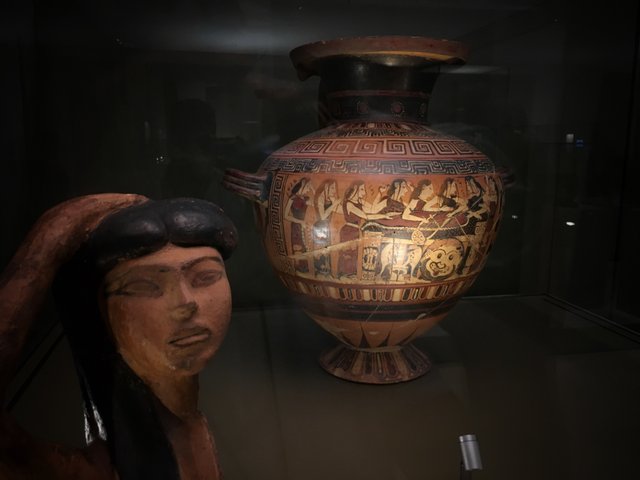

Conocí a una niña que sabe latín, cuando fui a ver la exposición "Músicas en la antigüedad".
La muestra está en el CaixaForum de Madrid y recoge obras procedentes del Museo del Louvre, el museo arqueológico de Atenas y otras instituciones.
La música está presente en todas las culturas porque, desde la antigüedad, se conoce su capacidad de generar emociones. Me gustó la presentación porque los organizadores han aprovechado el hilo conductor de la música para describirnos cuatro civilizaciones antiguas desaparecidas, de Oriente hasta Roma, pasando por Grecia y Egipto.
En la muestra se exhiben instrumentos, anotaciones musicales y múltiples representaciones iconográficas. Por ellos, comprendemos la importancia que tuvo la música en las culturas antiguas.
Desde el principio me informan que la música siempre ha estado vinculada al poder y a las celebraciones religiosas. También observo que muchos instrumentos son los mismos en todas las culturas.
Durante mi visita sucedió algo muy poco habitual. Estando junto a unos padres que visitaban también la exposición con su hija, me quedé atónito. Junto a unas vitrinas hay un texto escrito en latín. Observo que el padre lo lee junto a la niña que tendrá unos ocho años. Periódicamente, se para y le pregunta: ¿Entiendes? La chiquilla asiente: ¡entiende el latín!
No doy crédito a lo que estoy viendo, ¿por qué le han enseñado latín siendo tan pequeñita?
Además, todavía me sorprendo más porque la niña entiende también casi todas las palabras empleadas en los paneles explicativos y algunas no son fáciles. Por ejemplo, conoce lo que era una “lutería”.
En este punto estoy que no salgo de mi asombro. Casi estoy más interesado por la niña que por la propia exposición.

I met a girl who knows Latin, when I went to see the exhibition "Musics in Antiquity".
The exhibition is at the CaixaForum in Madrid and includes works from the Louvre Museum, the Archaeological Museum of Athens and other institutions.
Music is present in all cultures because, since antiquity, its ability to generate emotions has been known. I liked the presentation because the organizers have taken advantage of the theme of the music to describe four ancient civilizations that disappeared, from the East to Rome, through Greece and Egypt.
In the exhibition instruments, musical annotations and multiple iconographic representations are exhibited. For them, we understand the importance of music in ancient cultures.
From the beginning I perceive that music has always been linked to power and religious celebrations. I also note that many instruments are the same in all cultures.
During my visit something very unusual happened. Being next to some parents who also visited the exhibition with their daughter, I was stunned. There is a text written in Latin next to some showcases. I observe that the father reads it with the girl who will be about eight years old. Periodically, he stops and asks: Do you understand? The girl agrees, she understands Latin!
I do not believe what I'm seeing, why have you been taught Latin being so tiny?
Also, I'm still more surprised because the girl also understands almost all the words used in the explanatory panels that are not easy. For example, he knows what a "luteria" was.
At this point I am not getting over my amazement. I'm almost more interested in the girl than in the exhibition itself.

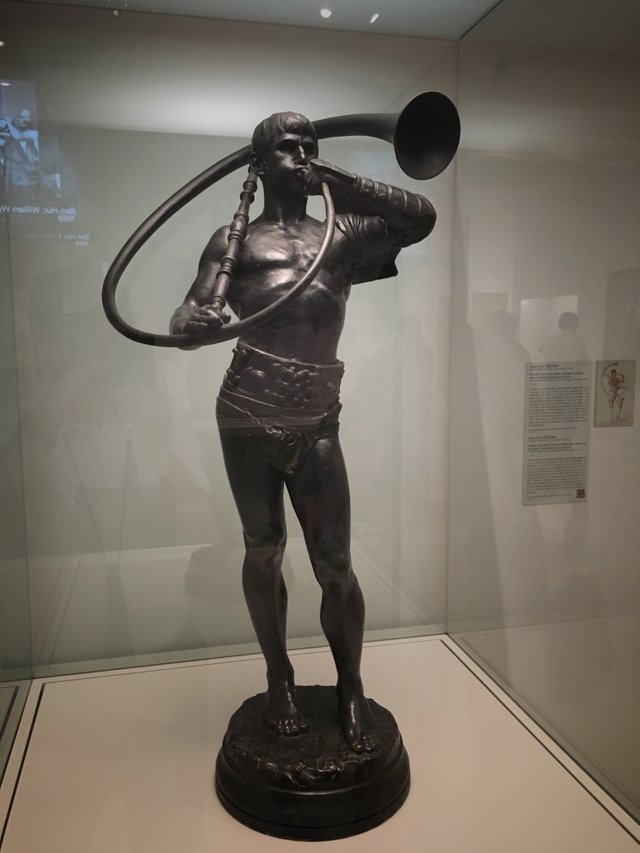
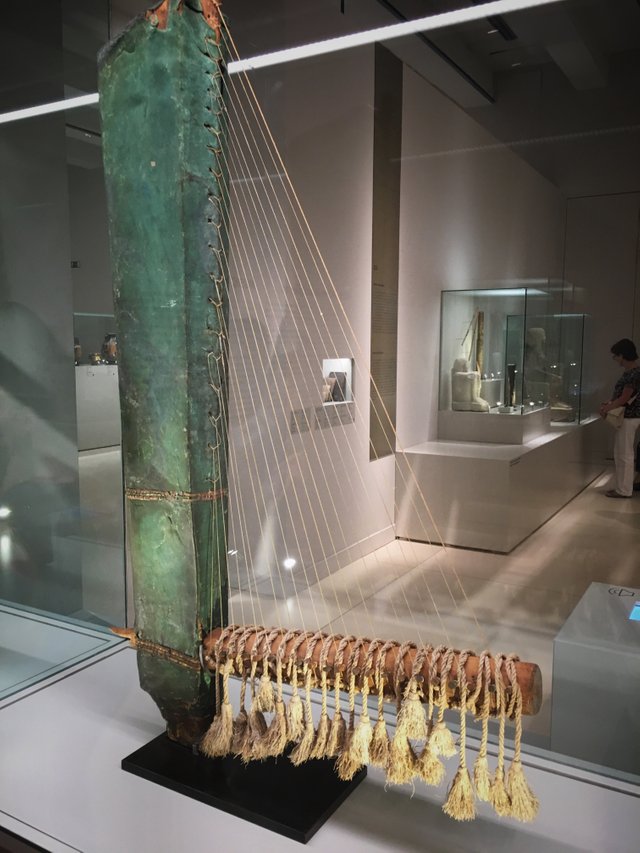
Me obligo a seguir el recorrido. No voy a estar persiguiéndolos. Percibo que en las salas se escucha suavemente de fondo, como ambientación, fragmentos musicales de algunos instrumentos.
Entre los objetos expuestos, en general, los objetos de bronce han resistido mejor los estragos del tiempo. Sin embargo, también se han conservado en un estado excepcional ciertos instrumentos realizados con madera y piel: es el caso de las arpas, las liras, los laudes, las panderetas, las flautas y los tambores.

I force myself to continue watching the exhibition. I will not be pursuing them. In the rooms, musical fragments of some instruments are listened to softly as a background.
Among the exhibits, in general, bronze objects have better withstood the ravages of time. However, certain instruments made of wood and leather have also been preserved in an exceptional state: this is the case of harps, lyres, lauds, tambourines, flutes and drums.

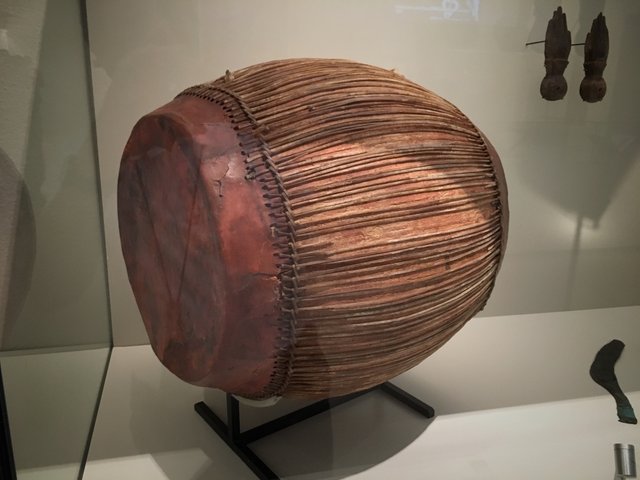
Algunos de mis amigos en Steemit son músicos y se maravillarían al ver un tambor egipcio perfectamente conservado. Tiene la forma de un pequeño barril y está formado por 24 tablillas pegadas unas junto a otras. Las membranas, situadas en ambos extremos, están atadas y tensadas mediante un sistema de tiras de cuero. Se tocaba con ambas manos. Al parecer, este tipo de tambor lo emplearon los egipcios en celebraciones nupciales y procesiones religiosas. El músico se lo colgaba del cuello mediante una cuerdecilla.

Some of my friends in Steemit are musicians and would be amazed to see a perfectly preserved Egyptian drum. It has the shape of a small barrel and is made up of 24 tablets stuck together. The membranes, located at both ends, are tied and tensioned by a system of leather strips. It was played with both hands. Apparently, this type of drum was used by the Egyptians in nuptial celebrations and religious processions. The musician hung it around his neck with a string.

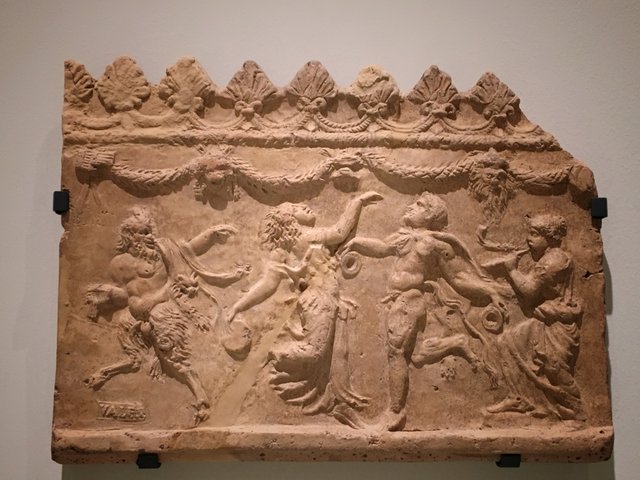
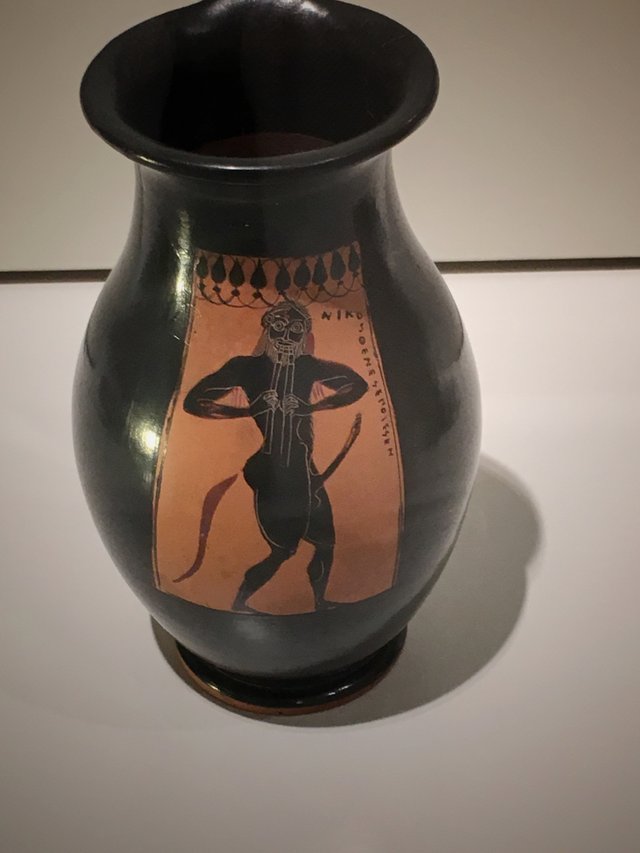
En la exposición explican claramente que en todas las culturas antiguas, los dioses tienen una estrecha relación con la música. Se conoce desde antiguo las propiedades “mágicas” de la música. Las divinidades solían tener un instrumento asociado y seguramente una composición musical.
En la mitología grecorromana, la invención de la música tiene algo de acto divino. Hermes utiliza la lira, Pan la flauta y el aulados (un aflauta doble). Apolo recuperó la lira que tocaba Hermes.
Para honrar a los dioses, la voz de los sacerdotes, el sonido los instrumentos musicales, los cantos y las llamadas al silencio marcaban los momentos más destacados de las ceremonias religiosas. En cada uno de estos ritos, la música tenía la función de establecer una comunicación directa con las divinidades. La música era esencial para el buen desarrollo de las ceremonias religiosas porque creaba una atmósfera adecuada para llamar y dirigir la atención de los dioses.
De nuevo vuelvo a encontrarme con la niña. No puede evitar escuchar como su padre, le pregunta: ¿esto que puede ser? La chiquilla, con su vocecita, muchas veces contesta correctamente. Es como un juego.

In the exhibition they explain clearly that in all ancient cultures, the gods have a close relationship with music. The "magical" properties of music have been known since ancient times. The deities used to have an associated instrument and surely a musical composition.
In Greco-Roman mythology, the invention of music has something of a divine act. Hermes uses the lyre, Pan the flute and the aulados (a double flute). Apollo recovered the lyre played by Hermes.
To honor the gods, the voice of priests, the sound of musical instruments, songs and calls to silence marked the highlights of religious ceremonies. In each of these rites, music had the function of establishing a direct communication with the gods. Music was essential for the proper development of religious ceremonies because it created an adequate atmosphere to call and direct the attention of the gods.
Again I meet the girl again. He can not help but listen as his father asks: what can this be? Many times he answers correctly. It's like a game.
The girl, whose name is Lucia, seems to enjoy. He jumps up and reads the explanations on the panels next to the father. For example, I listen to her read carefully and loudly and hallucinate when I hear her say "Greco-Roman" all followed and unlocked. I have my eyes wide open! I don´t believe it.

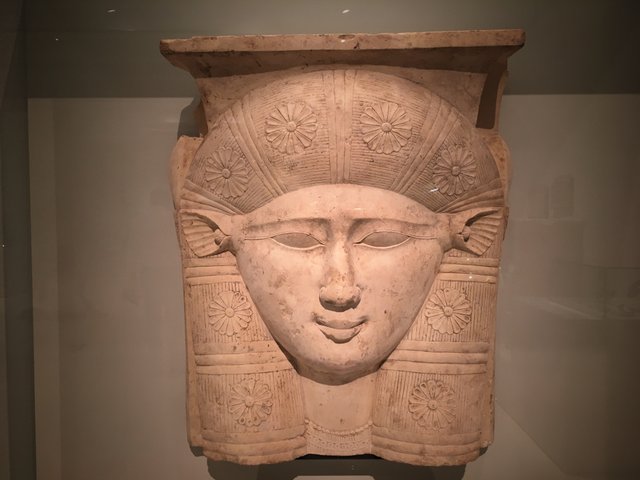
Vuelvo a prestar atención a la exposición. En esta parte explican que la diosa Thor es venerada como la diosa de la música, la danza y la alegría. Esta divinidad se representaba habitualmente con la fisonomía de una mujer joven, con orejas de vaca y unos cuernos que rodeaban un disco solar.
Sus instrumentos musicales eran el sistro, una especie de sonajero cuyo mango se decoraban a menudo con la imagen de la diosa. Simbólicamente, su sonido tenía una función regeneradora y protectora. Este instrumento ritual, típicamente egipcio, se extendió por occidente y se mantuvo en el resto de las culturas.

I pay attention to the exhibition again. In this part they explain that the goddess Thor is venerated as the goddess of music, dance and joy. This divinity was usually represented with the appearance of a young woman, with cow ears and horns that surrounded a solar disk.
Their musical instruments were the sistro, a kind of typical Egyptian rattle whose handle was often decorated with the image of the goddess. Symbolically, its sound had a regenerative and protective function. This ritual instrument, typically Egyptian, extended to the west and remained in the rest of the cultures.

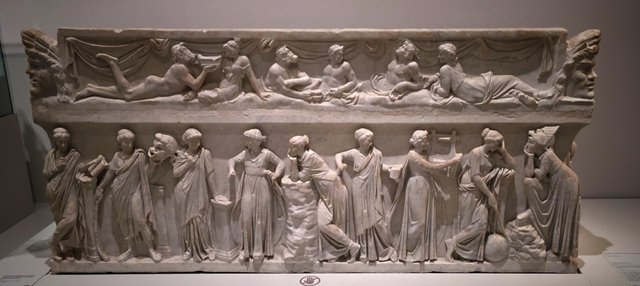
LLego a un sarcófago romano muy bien conservado. En sus lados están talladas las nueve musas en bajorrelieves.
I see a very well preserved Roman sarcophagus. On its sides are carved the nine muses in bas-reliefs.

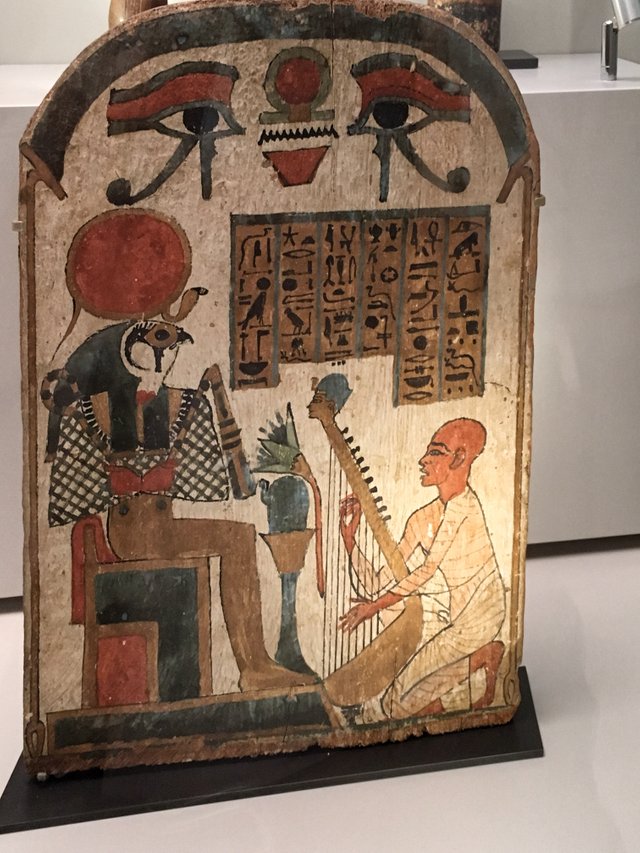
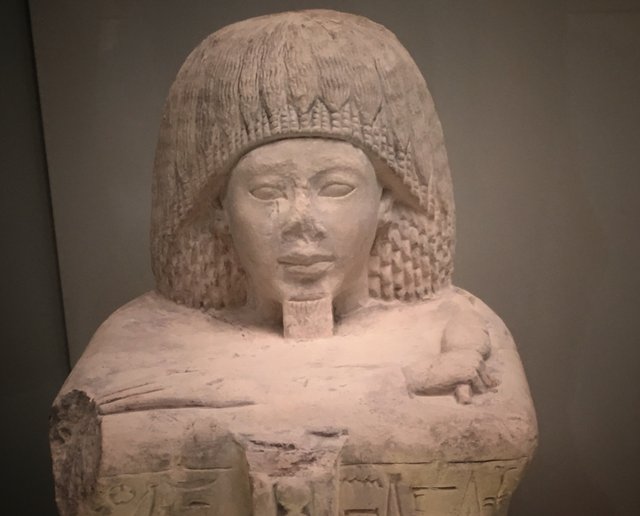
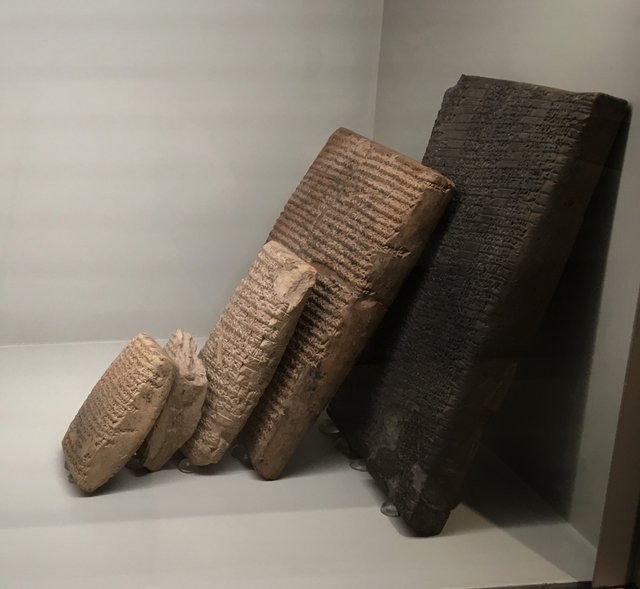
Me quedo un rato mirando una vitrina que contiene unas tablillas de barro, encontradas en Uruk, con escritura cuneiforme, es decir, con pequeñas muescas. Me sorprende la explicación que indica que en ellas están escritos los cantos destinados a una divinidad.
Como ya dije, la música formaba una parte fundamental del ceremonial del poder y de la puesta en escena de la autoridad. Por ello, en la antigüedad había un gran número de músicos al servicio de los poderosos. En la exposición hay muchas representaciones de músicos, ya sea pintados o moldeados.
En las monarquías antiguas, la música tenía la función de animar la vida de la corte, de marcar el ritmo de los cortejos, de resaltar el poder del soberano emanado de lo divino o de marcar el ritmo de las campañas militares con el ritmo de los tambores y el sonido de las trompetas.
La música, siempre omnipresente en los rituales cívicos, contribuyó al funcionamiento de las antiguas civilizaciones. En Grecia incluso era una parte esencial de la educación del ciudadano. En el mundo grecorromano se empleó profusamente en todas las procesiones y los certámenes públicos. De igual forma, la música realzaba las magnas procesiones triunfales del imperio romano.

I stay for a while looking at a display case containing some clay tablets, found in Uruk, with cuneiform writing, that is, with small indentations. I am surprised by the explanation that indicates that the songs destined for a divinity are written in them.
As I said, music was a fundamental part of the ceremonial power and the staging of authority. Therefore, in antiquity there was a large number of musicians at the service of the powerful. In the exhibition there are many representations of musicians, either painted or molded.
In ancient monarchies, music had the function of animating the life of the court, of marking the rhythm of courtship, of highlighting the power of the sovereign emanating from the divine or of marking the rhythm of military campaigns with the rhythm of drums and the sound of trumpets.
Music, always omnipresent in civic rituals, contributed to the functioning of ancient civilizations. In Greece it was even an essential part of the education of the citizen. In the Greco-Roman world, it was used profusely in all processions and public competitions. In the same way, the music enhanced the magnificent triumphal processions of the Roman Empire.

En la cultura griega era muy importante la formación humanista. En el siglo quinto a. c., el teatro era una representación total que combinaba la trama dramática, con la música y la danza. La construcción de los teatros griegos en lugares únicos y emblemáticos lo demuestra. Cuando estuve en Taormina, hice esta foto porque me quedé totalmente asombrado con que edificaran el teatro orientado justamente para tener una visión de fondo el volcán Etna y el mar. Nada que ver con lo que sucede en nuestros días.
En aquella época era importante que los ciudadanos estuvieran instruidos y se les enseñaba todo este repertorio literario y musical. Se entendía que era un conocimiento básico estar capacitado para tocar la lira y cantar durante los banquetes y en aquellos otros momentos importantes de la vida social. Entonces, se combinaba la música con el vino y la poesía.

In the Greek culture, humanistic education was very important. In the fifth century a. c., the theater was a total representation that combined the dramatic plot, with music and dance. This is demonstrated by the construction of Greek theaters in unique and emblematic places. When I was in Taormina, I made this photo because I was totally amazed because they built the theater oriented just to have the volcano Etna and the sea in the background. Nothing to do with what happens in our days.
At that time it was important that citizens were educated and taught all this literary and musical repertoire. It was understood that it was a basic knowledge to be able to play the lyre and sing during banquets and in those other important moments of social life. Then, music was combined with wine and poetry.

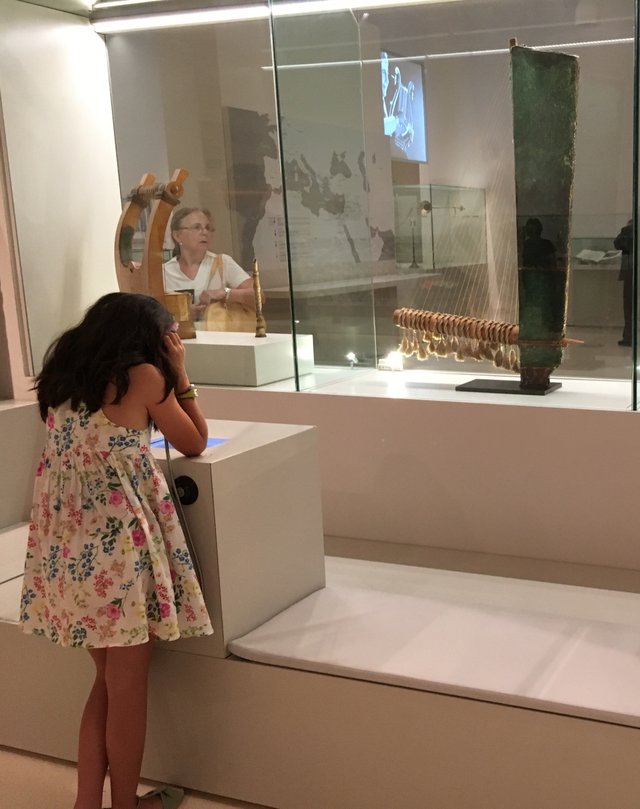
Todo esto se lo explican a Lucia.
¡Qué alegría debe sentir este padre que siente que lo que le enseña a la niña no cae en “saco roto”!
Lucia es una niña de unos ocho años, con media melena de pelo muy negro y que lleva una preciosa diadema de florecitas. Parece una ninfa. Como todas las niñas seguramente se cansará de estas exposiciones, pero los padres tienen mucha mano izquierda y solo la estimulan en algunos momentos determinados para atraer su atención sobre algo sin agobiarla.

All this is explained to Lucia. What a joy this father must feel that he feels that what he teaches the girl does not fall into "broken bag". It is a girl of about eight years, with half a mane of very black hair and wearing a beautiful diadem of flowers. It looks like a nymph. Like all girls, she will probably tire of these exhibitions, but parents have a lot of left hand and only stimulate her at certain moments to attract her attention to something without overwhelming her.

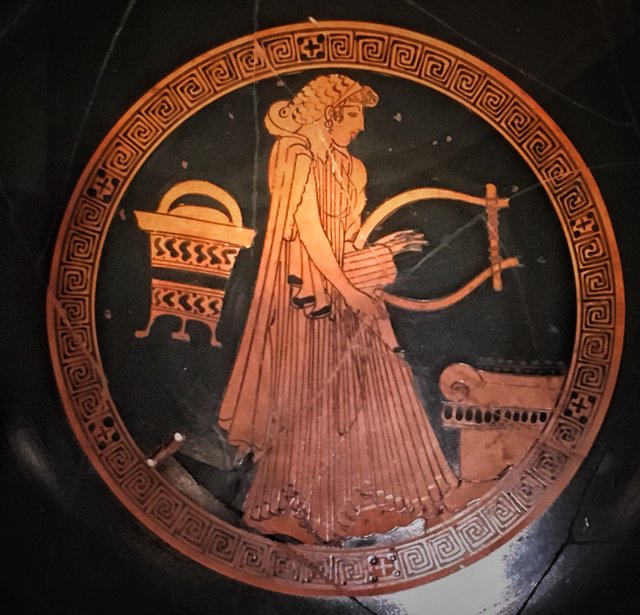
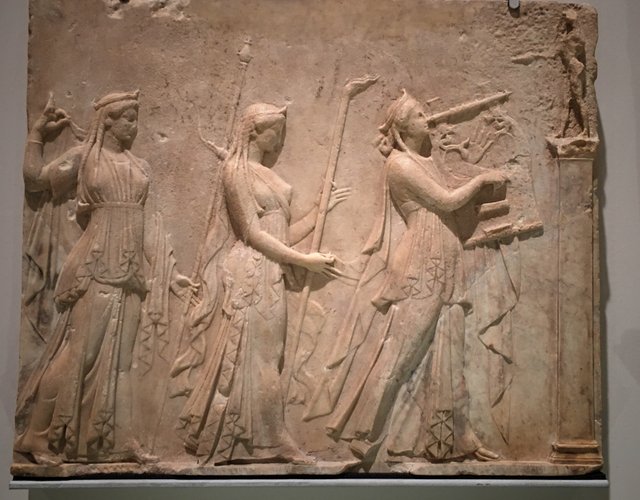
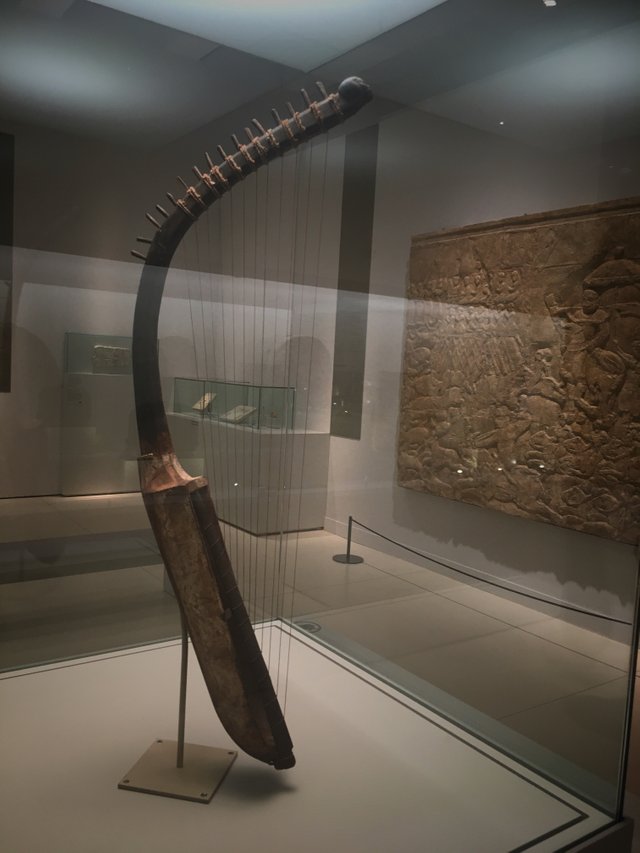
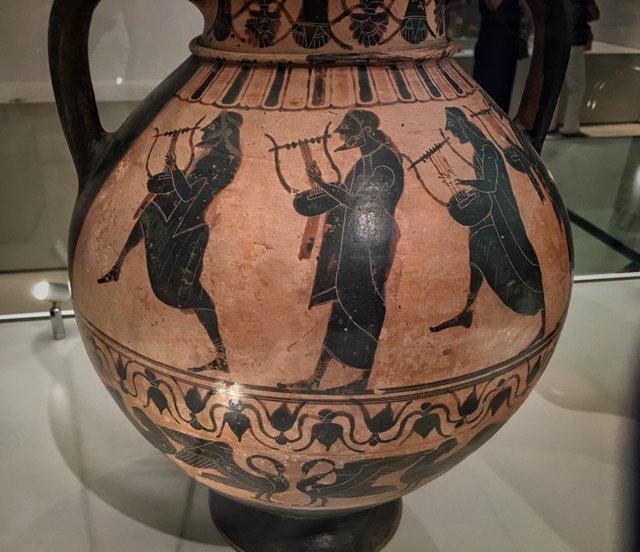
El espíritu competitivo fue muy importante en las ciudades griegas. Los mejores músicos se enfrentaban en certámenes musicales. El festival de Delfos, proporcionaba una gran fama a los ganadores. Esto se aprecia perfectamente en la cerámica de figuras negras y rojas.
Los romanos también implantaron este tipo de certámenes. De hecho, el propio emperador Nerón participó en ellos cantando y tocando su citara.
Las sociedades antiguas conocían la capacidad de la música para influir en el estado de ánimo. Según sus efectos, la música fue recomendada para curar, aunque también se prohibió, por ejemplo, en el culto a Osiris en Egipto.
La música se empleó en ritos determinados, por ejemplo, los relacionados con el nacimiento y la muerte.
De todo esto me enteré en la exposición, pero también aprendí que, desde la antigüedad, el sonido de los objetos metálicos como las campanillas o cascabeles tenían una dimensión mágica. Ahora comprendo por qué los monaguillos hacían sonar la campanilla en el momento de la consagración en la ceremonia de la misa.

The competitive spirit was very important in Greek cities. The best musicians faced each other in musical contests. The festival of Delphi, gave a great fame to the winners. This is perfectly appreciated in the ceramics of black and red figures.
The Romans also implanted this type of contests. In fact, the Emperor Nero himself participated in them singing and playing his quote.
Ancient societies knew the ability of music to influence mood. According to its effects, the music was recommended to cure, although it was also forbidden, for example, in the cult of Osiris in Egypt.
The music was used in certain rites, for example, those related to birth and death.
I learned about all this in the exhibition, but I also learned that, since antiquity, the sound of metallic objects such as bells or jingle bells had a magical dimension. Now I understand why the altar boys were ringing the bell at the time of the consecration at the mass ceremony.
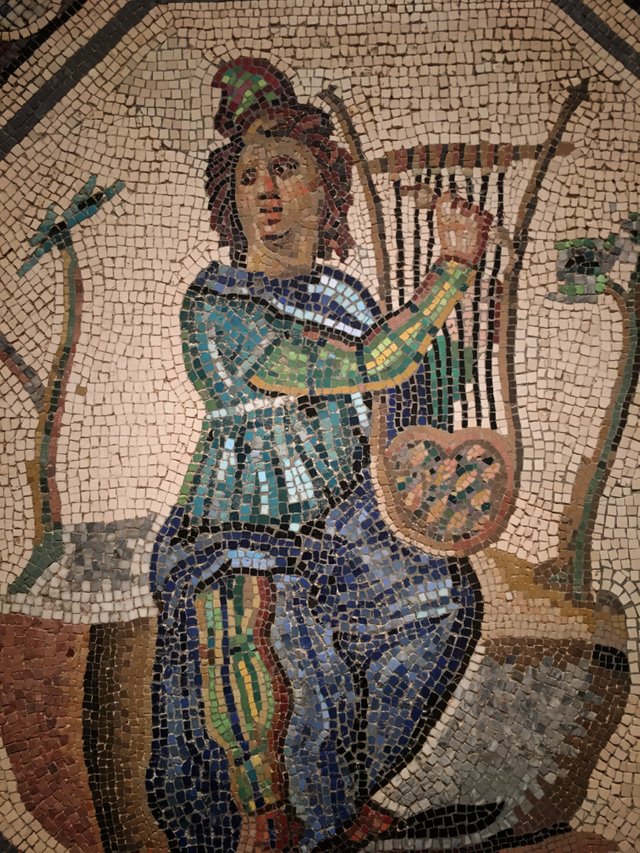
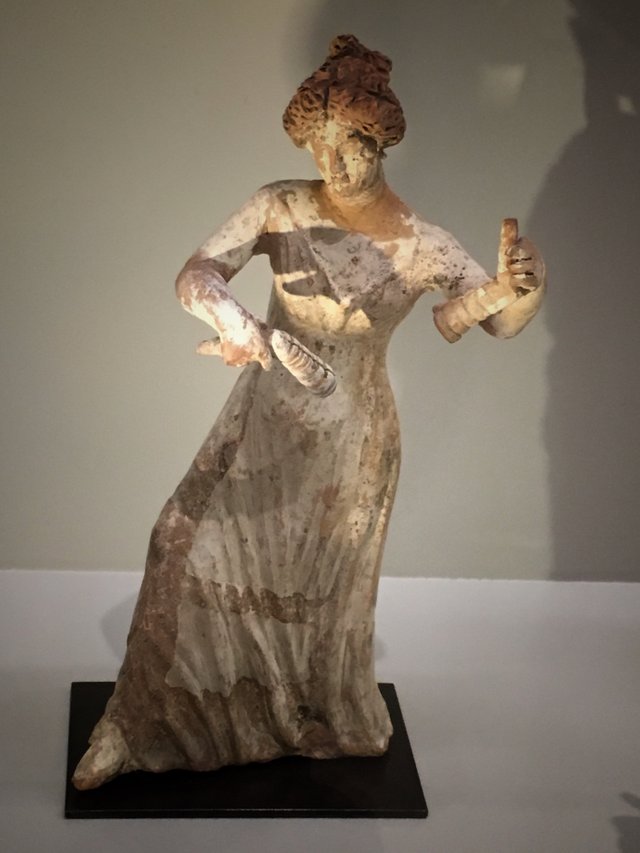

Orfeo, el dios de la música, fue un motivo decorativo muy empleado en los pavimentos de las casas romanas.
Orfeo, the god of music, was a decorative motif very much used in the pavements of Roman houses.

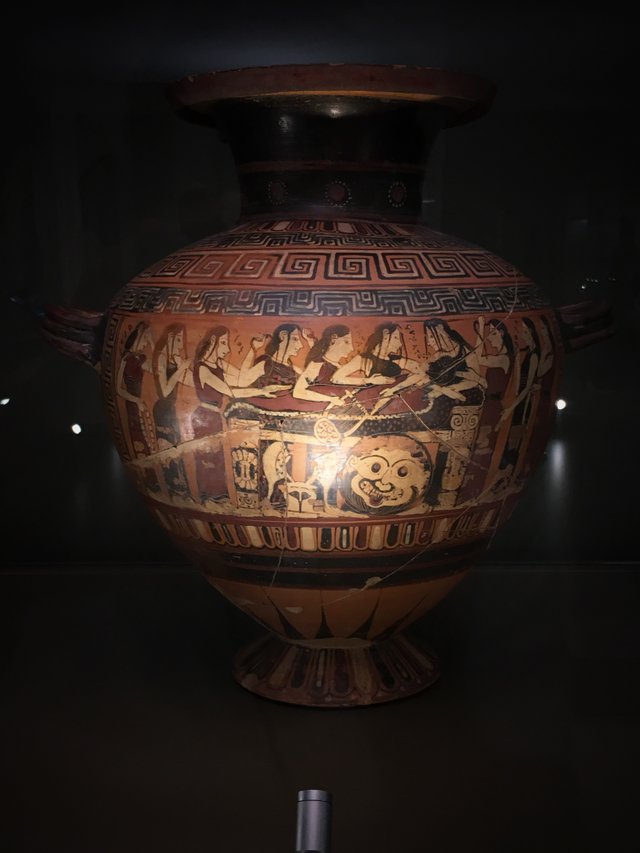
Un jarrón griego muy bien conservado de figuras negras, llamó mi atención. Largo rato estuve observándolo. Al parecer, representa a Aquiles muerto y amortajado en la guerra de Troya. Su madre rodea su cabeza con sus brazos mientras las plañideras, las nereidas, lloran y se tiran del pelo por su muerte.
Hoy en día, podemos conocer cómo sonaban estos instrumentos, pero nada sabemos de las melodías de las composiciones musicales porque no se hicieron partituras.

A very well preserved Greek vase with black figures caught my attention. I was watching him for a long time. Apparently, it represents Achilles dead and shrouded in the Trojan War. Her mother circles her head with her arms while the mourners, the nereids, cry and pull their hair by his death.
Nowadays, we can know how these instruments sounded, but we do not know anything about the melodies of the musical compositions because scores were not made.

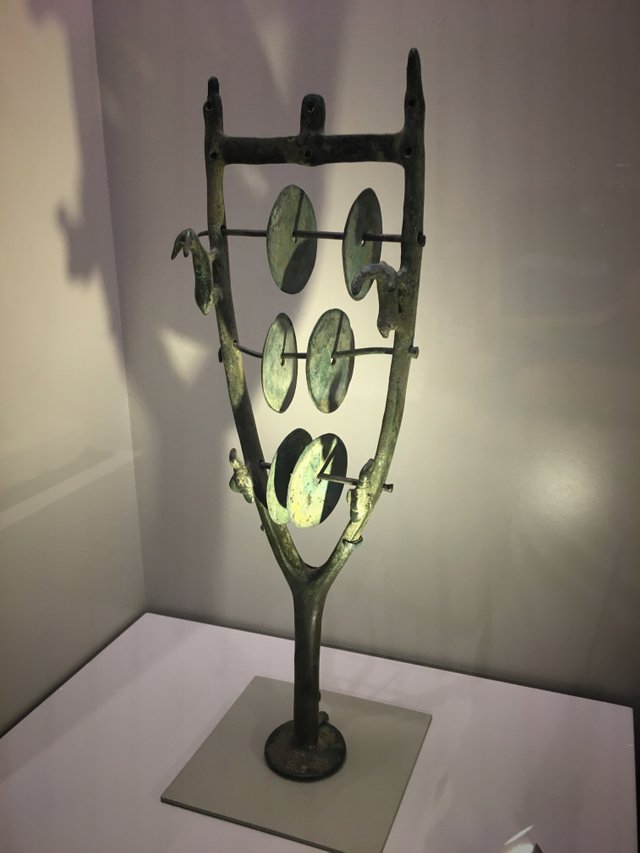
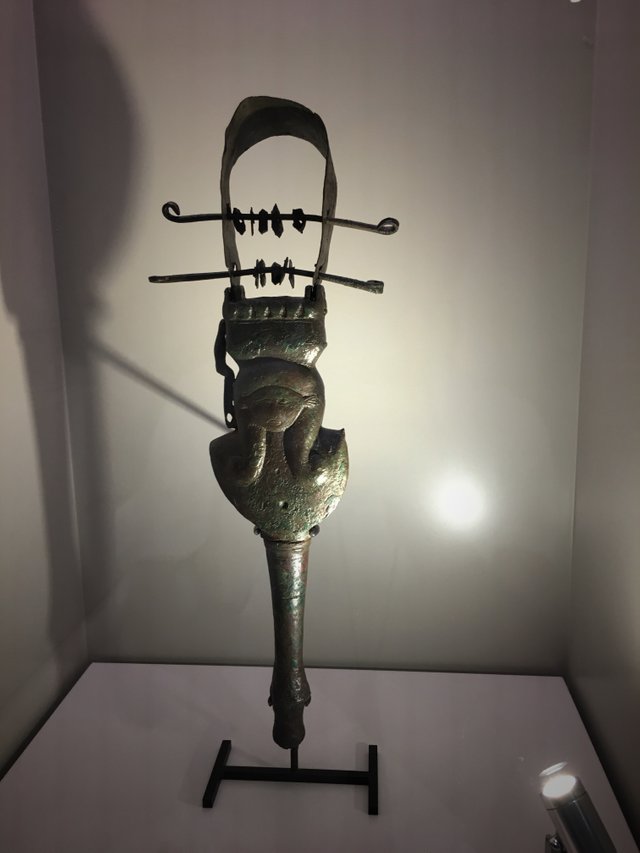
El sistro hallado cerca de Roma, concretamente en el templo de Isis situado en el campo de Marte, demuestra la difusión de los cultos egipcios en la capital del imperio romano. Era un sistema arqueado con tres varillas y con un mango ricamente decorado.
Los músicos intervinieron decisivamente en las campañas militares, tanto en el campo de batalla como en los campamentos. Daban las señales necesarias para el correcto funcionamiento de los ejércitos. Llamaban al ataque o a la retirada. Pero, además tenían la función de animar a los soldados.
Termine la visita y Lucia ya se había ido. Me froté los ojos todavía con incredulidad.

The sistro found near Rome, specifically in the temple of Isis located in the field of Mars, demonstrates the spread of Egyptian cults in the capital of the Roman Empire. It was an arched system with three rods and a handle richly decorated.
The musicians played a decisive role in the military campaigns, both on the battlefield and in the camps. They gave the necessary signals for the correct functioning of the armies. They called for attack or withdrawal. But they also had the function of encouraging the soldiers.
Finish the visit and Lucia was already gone. I rubbed my eyes still in disbelief.

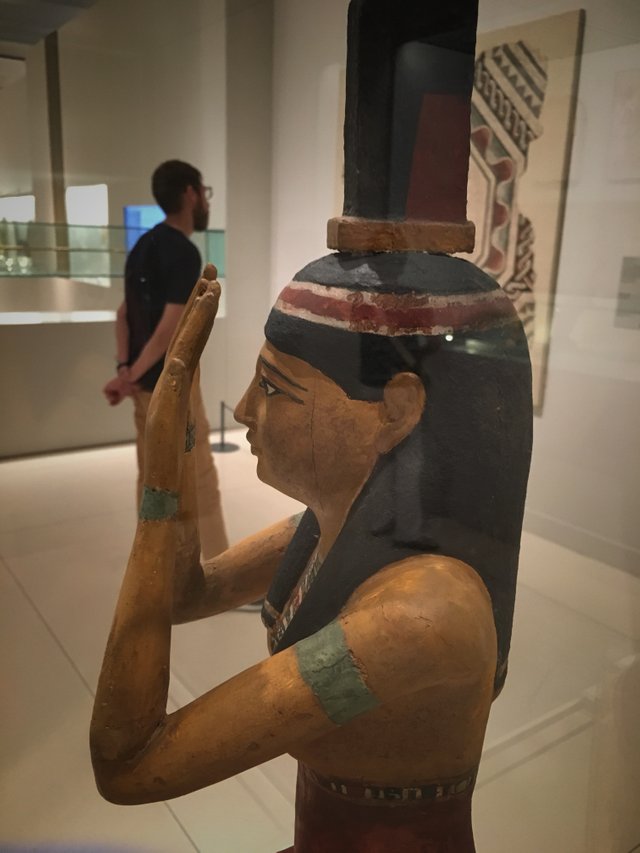
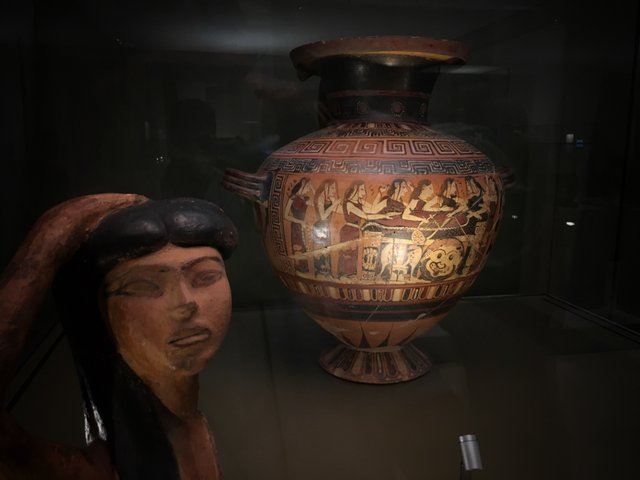
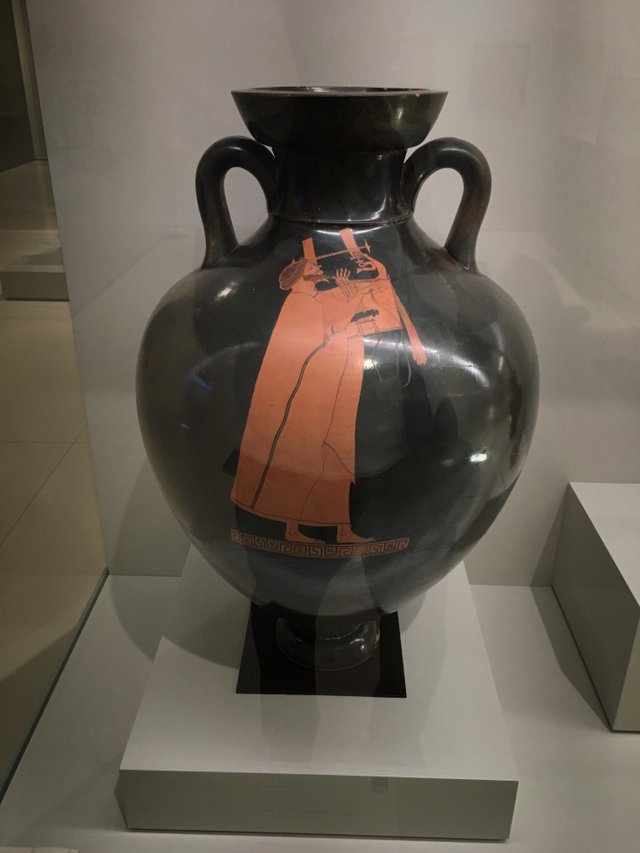
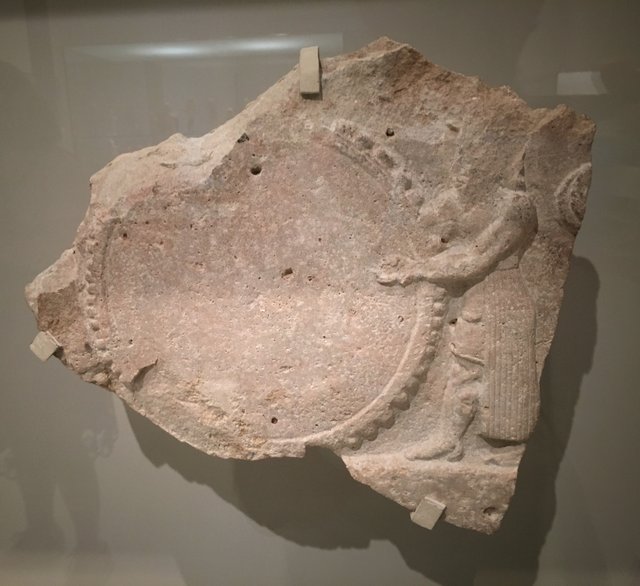
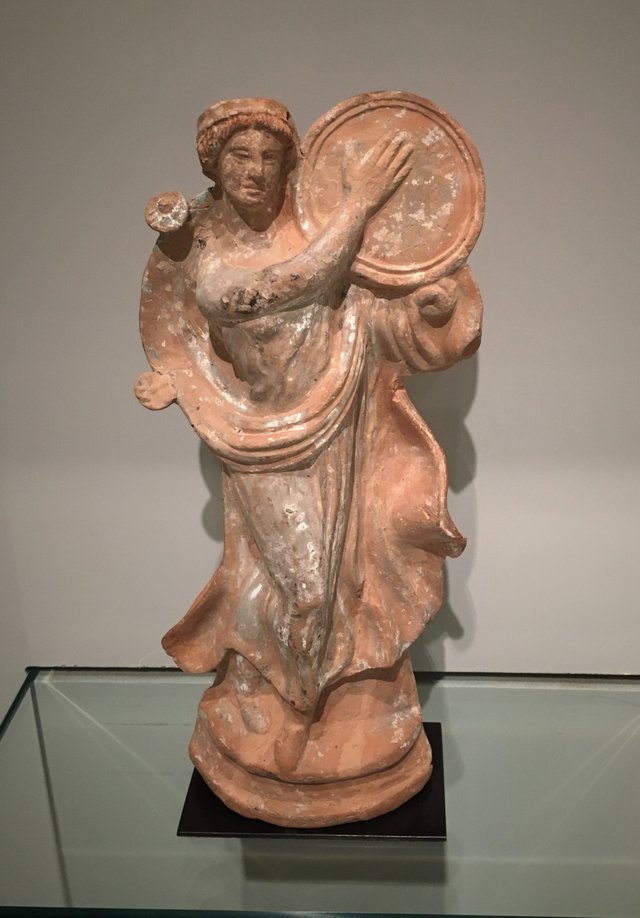

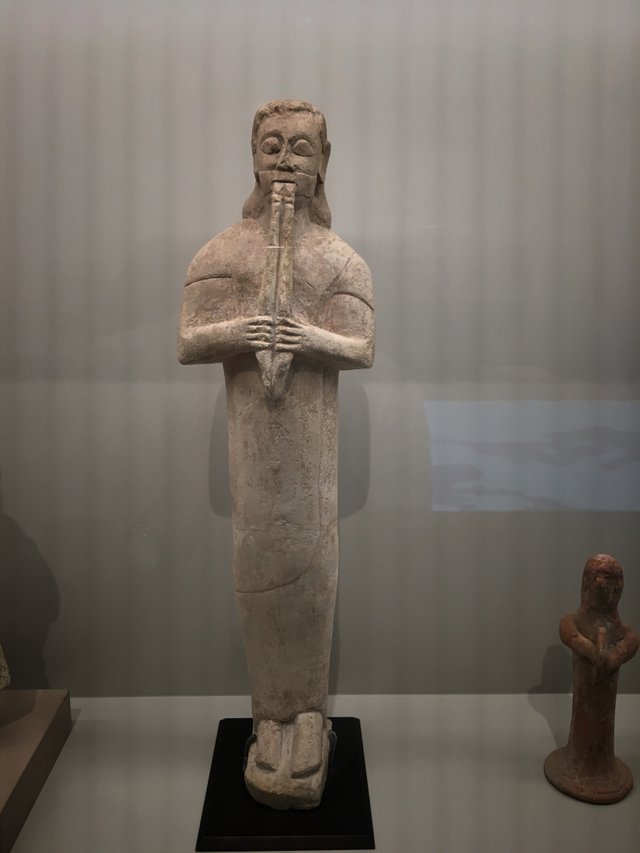
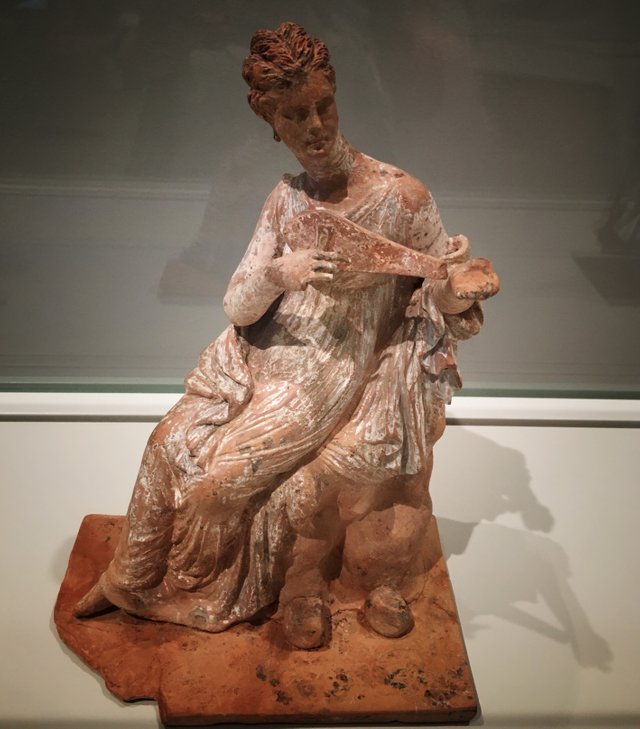

Espero, sinceramente, que te haya gustado esta publicación. La he escrito con ilusión recordando el viaje. Mi intención ha sido que me acompañaras, proporcionándote información pero sin resultar aburrido. Espero contar contigo en otras experiencias.
I sincerely hope that you liked this publication. I wrote it with enthusiasm remembering the trip. My intention has been to accompany me, providing information but without being boring. I hope to count on you in other experiences.


Todas las fotos son mías y originales. Las hice con mi iPhone 6. Así mismo, soy el autor de los dibujos separadores.
¡Espero tus comentarios!
All the photos are original and mine. I made with my iPhone 6. Also, I am the author of the separator drawings.
I await your comments!
VÓTAME Y TE VOTARÉ
Si me votas, buscaré tus post y los votaré. Me gusta ser agradecido.
¡Compruébalo!
VOTE ME AND I WILL VOTE YOU
If you vote for me, I'll find your post and vote for them. I like to be grateful.
Check it!
¡Buen Camino!
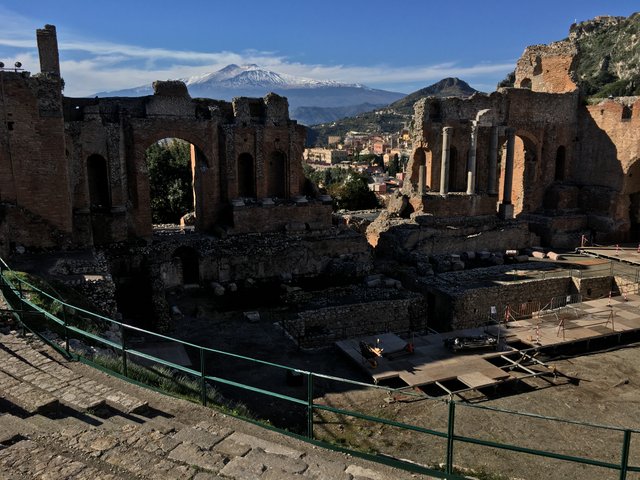
Cuando vemos arte de alta factura, con un texto haciendo compañía del modo como lo haces, nos regocijamos y decimos: "No todo está perdido, mientras existan personas sensibles al arte"
¡Votado por Engranaje!
Jejeje 😂
Muchas Gracias 😊
Lo escribí con ilusión.
Precioso artículo, la mayoría de las veces somos como nos moldearon nuestros padres, bravo por los de Lucía y por ella también. 😉
Un abrazo
Ciertamente pero el ADN de los niños es un factor fundamental. Aunque los padres deseen moldear y potenciar al hijo en una dirección, será imposible si no hay un sustrato genético que lo permita. Es muy complicado. Admiro a estos padres que sutilmente lo saben hacer.
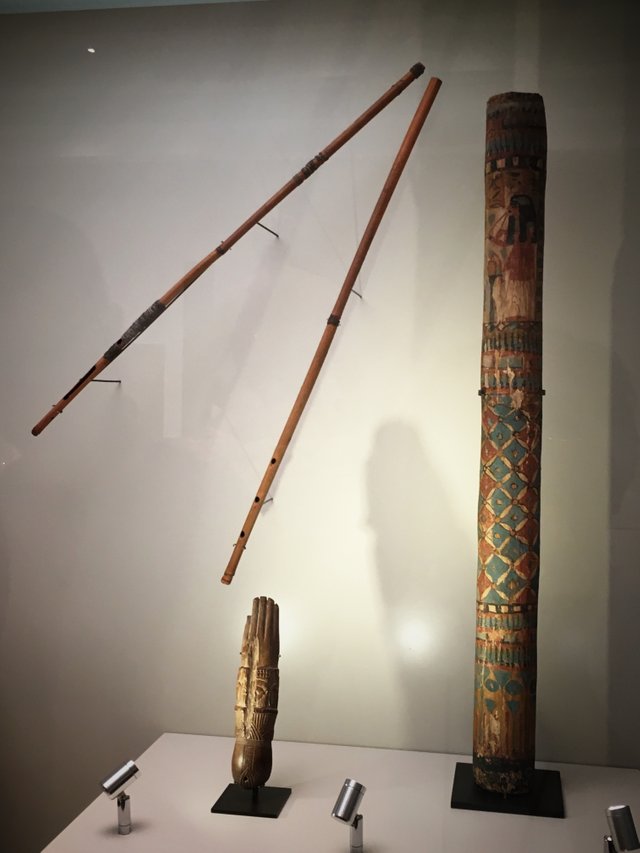
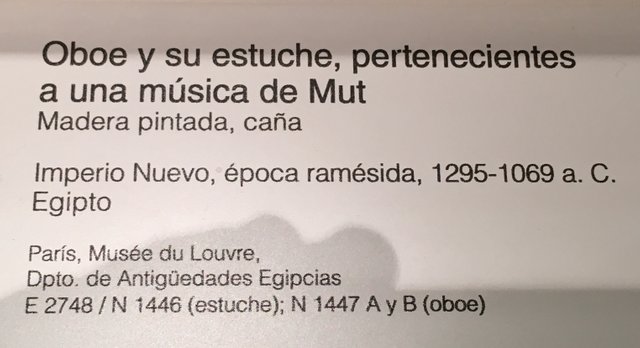
Te dedico este oboe doble egipcio que se ha conservado inalterado con su estuche desde hace mas de 3000 años. Esto si que es hacer las cosas bien! 😊
¡Qué bonito!
Gracias 🤗
I hope you will upvote me back
https://steemit.com/life/@ravikd009/humans-at-sea
Me gusto tu publicación de motos 🏍
Muy interesante tu trabajo. Sentí que hacia un recorrido por un museo. Saludos y gracias.
Gracias por leerlo
Mi intención fue que sintieras que estabas allí mismo, en la misma exposición. Que te emocionaras como yo de la vision de estos objetos milenarios. Por eso la escribí en presente.
Me alegro que te gustara. Espero que mantengamos otros correos mas adelante. Un saludo 😊
Lo lograste. Te continuaré visitando
Genial 😀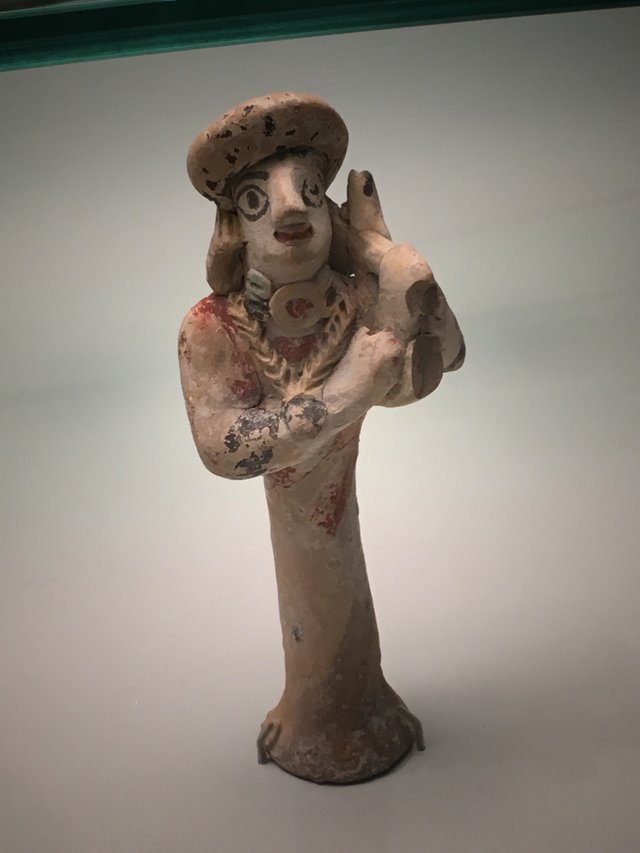
Un regalito por ello. Jeje
Muchísimas gracias. Es preciosa!!!
¡Ovación de pie!
Me alegro que te gustara la publicación. Invertí mucho tiempo y esfuerzo para que la pudierais disfrutar. Sobretodo la escribí con cariño. 😊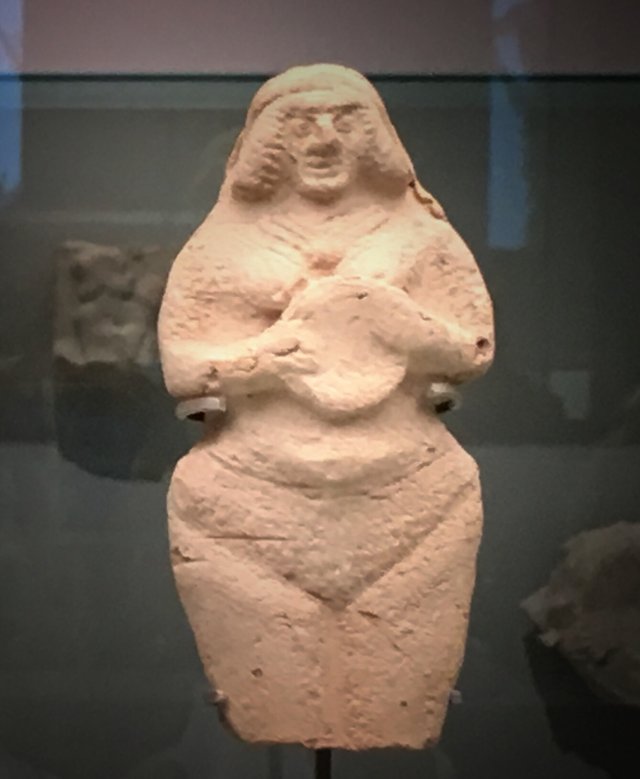
Te dedico esta pequeña estatuilla que no puse poner.
Uyyyy...eso se nota a leguas...sin dudar, merecedora de un voto Curie..!
Muchas gracias por la estatuilla..!
I don't understand the language but the pictures are amazing ..... Very pretty
Thank you. The text is also translated into English. Look good. Thank you. 😊
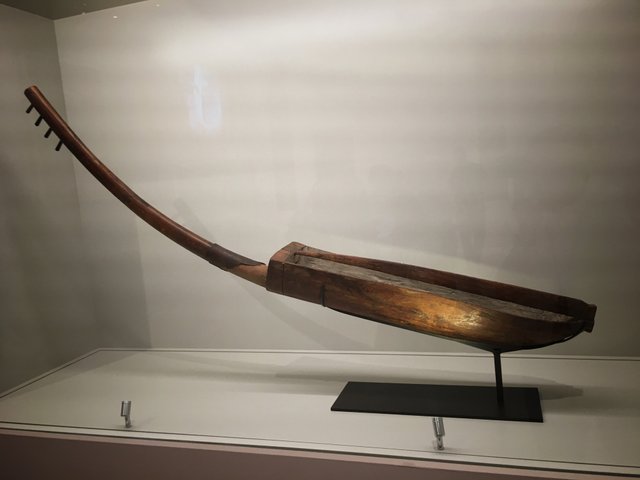
upvote for me please? https://steemit.com/news/@bible.com/6h36cq
Hola, que interesante, siempre aprendo algo nuevo con tus post.
Y lo de la niña, sorprendente, no comprendo como algunos niños tienen tanto talento, para algunas cosas. Saludos.
Ya me llamo la atención que el padre le preguntara si sabía lo que era “lutería “, pero cuando la vi leyendo en latín... 😳
Alucinante!
hola volcan aqui viendo tu trabajo saludos
Bueno, pues ire a ver el tuyo...🤔
Wuao... excelente post... que viaje tan bello haz compartido.. me encanto... Felicidades
Muchas gracias 😊
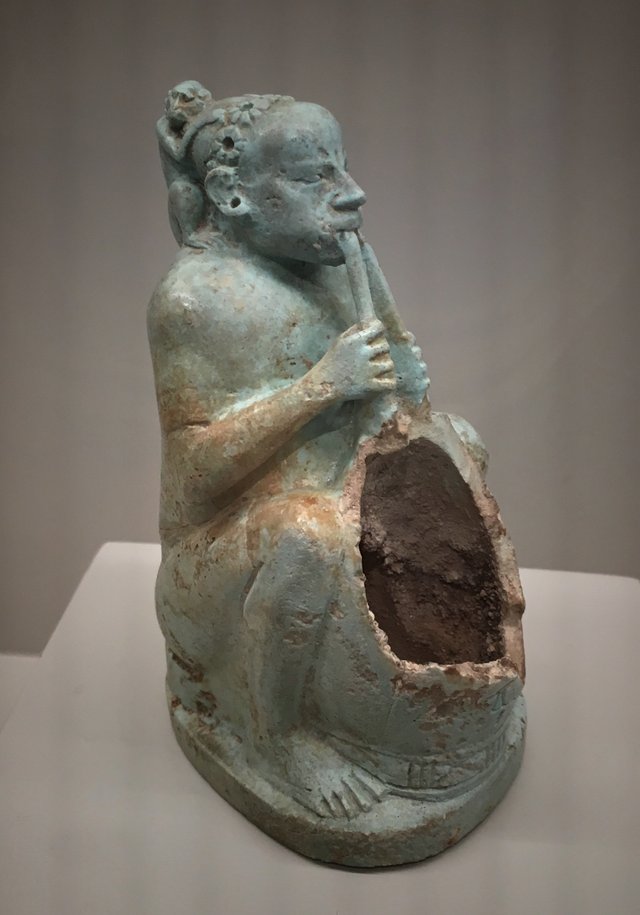
Te dedico una foto de una figura tocando un doble oboe. Seguro que te gustará. Solo tiene 2500 años 😊